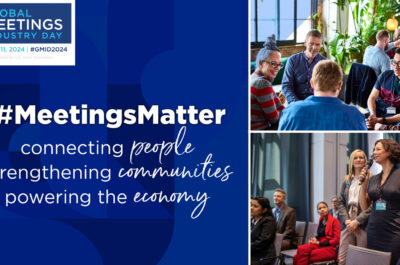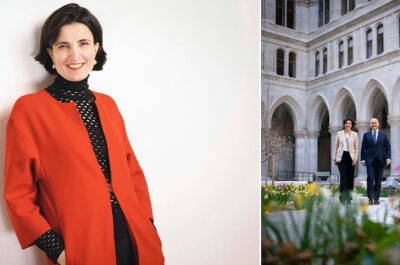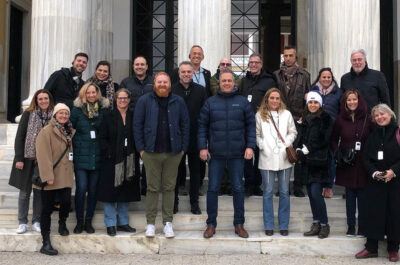The 3,389 events held in Vienna in 2013 can be divided into the following categories: 1,221 were congresses (+7%), 544 of which were national (+24%) and 677 international (-4%), 2,168 were corporate events (conferences and incentives) (-3%), 819 of which were national (-18%) and 1,349 international (+9%). Together they contributed 1,401,888 bednights, or 11%, to Vienna's total volume of bednights in 2013.
Despite slight increases in the number of events and delegates, Vienna was unable to exceed its own 2012 record congress results due to the fact that fewer bednights and less value-added were generated in 2013. This was reported by Director of Tourism Norbert Kettner at a press conference held on Friday, April 25 together with Christian Mutschlechner, Director of the Vienna Tourist Board’s Vienna Convention Bureau. The guest speaker was Peter Baierl, Executive Director of the European Society of Radiology, who spoke about the European Congress of Radiology held in March. The congress is held exclusively in Vienna, and celebrated its 20th anniversary this year.
Norbert Kettner drew up the following summary of 2013’s results for the congress city of Vienna: “The number of congresses and corporate events held in Vienna in 2013 increased slightly compared to 2012 to a total of 3,389, or 13 events more than the previous year. There were also slightly more delegates, and a 1% increase in their number to 501,337 broke the half-million barrier for the first time. Although these were optimal figures, they nevertheless failed to translate into record results. This was because bednights generated by the congress and convention sector fell by 8% compared to 2012 to 1,401,888, and value-added of 832.17 million euros was 9% down on 2012’s level. Year-round jobs secured by Vienna’s meeting industry were reduced by the same extent to just under 16,000.”
The Director of Tourism gave the following explanation for the reasons behind this inconsistent development: “It was attributable to international congresses, which play a dominant role in Vienna’s conference business and demonstrated atypical characteristics in 2013. On the one hand, their number decreased for the first time since 2008, and on the other they were also not as well attended. In addition to this, there have never been so many events lasting just one day as in 2013. They were also anomalous in 2012, but in exactly the opposite direction: there are generally fewer of them in Vienna in even years, and more in odd ones. This depends on certain cycles in the choice of destination by major, ‘migratory’ international congresses. In contrast to this ‘rule’, we had a record number of international congresses in 2012, followed by a decline in 2013.
“It remains to be seen whether we are seeing a change in the cycle, or whether these were just ‘rogue’ years. Our Vienna Convention Bureau will probe the reasons for this and turn the results to good effect. At all events, we owe a debt of gratitude to all the players in the Vienna conference industry: as always, their excellent efforts produced results for 2013 the high level of which, even without a new record, once again confirmed Vienna’s standing as a top destination in the international congress business.”
Heavy-spending audience: average daily expenditure of 483 euros per delegate
The 3,389 events held in Vienna in 2013 can be divided into the following categories: 1,221 were congresses (+7%), 544 of which were national (+24%) and 677 international (-4%), 2,168 were corporate events (conferences and incentives) (-3%), 819 of which were national (-18%) and 1,349 international (+9%). Together they contributed 1,401,888 bednights, or 11%, to Vienna’s total volume of bednights in 2013. The average expenditure of the 501,337 delegates attending these events (+1%) was around 483 euros per head and bednight (comparable figure for all visitors to Vienna in 2013: around 250 euros).
Throughout Austria, the Vienna meeting industry generated value-added of 832.2 million euros in 2013 (-9%). This figure takes into consideration all turnover with a domestic impact: both direct spending by delegates, organizers, exhibitors and accompanying persons, as well as spending in “upstream” economic sectors (e.g. construction industry, food, beverage and tobacco industry, printing industry, banks, insurance companies, telecommunications companies, etc.). The sector generated tax revenues in the amount of 234.5 million euros, of which 154.4 million euros went to the federal government, 28.1 million euros to Vienna, and the remainder to the provinces and local authorities. The calculations for these economic and fiscal effects were provided by Consulting Dr. M. Stoff and are based on the “EVENT MODEL AUSTRIA” (Author: © Dr. Martina Stoff-Hochreiner).
Time increasingly precious: trend towards one-day conferences
Just how big an impact international congresses have on the overall results for Vienna’s conference industry is illustrated by the contributions they make to important key indicators: whilst accounting for just 20% of the total number of events in 2013, they generated 46% of all delegates, 70% of bednights, and 75% of value-added in this sector. This means that, although they failed to reach the record levels of 2012, they nevertheless surpassed all other previous years. A structural change could also be seen here in 2013: whereas medical congresses used to be predominant – in 2012 they accounted for half of all international congress bednights – last year their share was only 44%. As a result, the proportion of congresses on economic / political and technical themes increased, though these do not generate as much turnover as medical events.
The number of national congresses increased by almost a quarter in 2013, and international corporate events grew by 9%. However, despite growth in delegates, bednights and value-added, these did not have sufficient weight to compensate for the decline in international congresses. We saw exactly the opposite development in corporate events in 2013, where a decline in national events contrasted with an increase in international ones, which have displayed a positive trend for the last three years.
One-day conferences are generally on the up, and have seen a particularly significant increase for international events in the last ten years: whereas in 2004, only 2% of them were so short, in 2013 their share was 15%. It is impossible to counter this global trend: time has become such a precious commodity that people use it as sparingly as possible in all areas of life.
Vienna Tourist Board and Vienna International Airport working together to obtain new direct flights
In order for Vienna to maintain its top position amongst the international congress destinations despite such adversities, as Norbert Kettner pointed out, suitable measures must be taken and also worked on with perseverance: “All the players in the Vienna meeting industry,” he emphasized, “are doing excellent work in this regard, continually optimizing their products and services to meet the latest demands of the congress world, thus helping to secure Vienna’s reputation as a ‘state-of-the-art’ congress destination. They are optimally supported by our municipal and academic institutions, as well as by Austrian Airlines, which this year has invested more than ever in its joint marketing effort with us, and also by Vienna International Airport. The Vienna Tourist Board has been cooperating with the latter since 2013 in order to place greater emphasis on airline marketing.
This primarily involves acquisition negotiations on the introduction of new direct flights to Vienna. In September we shall be taking part in “Routes World” in Chicago, the world’s largest fair for route development, for the second time with a view to providing airlines with all the relevant information about Vienna and convincing them of its value as a destination. Our growth strategy for air traffic to Vienna – with a special emphasis on long-haul flights – is generally a key factor in the continued development of Vienna tourism. This is particularly true of congress tourism, because 76% of our congress delegates travel by air, and as many as 81% of those attending international congresses, the importance of which has already been described. The figures I have already mentioned demonstrate just how much importance is now attached to time saving – getting here as fast as possible without having to change flights, for example.”
European Congress of Radiology: in Vienna for the 20th time in 2014
The European Congress on Radiology (ECR) stands out particularly amongst Vienna’s major international congresses. Not only is this one of the largest medical congresses worldwide, but it is convened exclusively in Vienna, and has always been at the Austria Center Vienna (ACV). It was held every two years from 1991 thru 1999, and annually since 2000 – this year for the 20th time from March 6 thru 10. This anniversary event attracted 20,010 delegates from 115 countries, and 300 companies presented their products at the largest medical exhibition of any congress in Europe, with over 26,000 squm of space.
The continuous growth of the ECR required more and more space, so the Austria Center Vienna had already added two exhibition halls to its building specially for this “regular”. However, this year even this was not sufficient: in order to be able to accommodate more than 1,800 lectures at ECR 2014, the European Society of Radiology and the Austria Center Vienna successfully negotiated with the “Vienna-based organization” of the United Nations, and were consequently permitted to use the latter’s conference facilities in a hall at the Vienna International Center for the first time.
Peter Baierl, executive director of the European Society of Radiology, gave the following report on this event: “We have not only celebrated this anniversary in an appropriate manner, but also lived up to our reputation as one of the most modern medical congresses in the world. For instance, for the first time ever we were able to test and train on the latest computer applications for radiology on-site under the guidance of an expert in a ‘multimedia classroom’. However, our greatest technical achievement was probably the installation of the ‘ECR Live’ platform on which all our lectures were streamed on the web – free and in real time. Interested parties from all over the world not only had the opportunity of following the congress at home, but also of actively participating. The ‘ECR Live Social Media Wall’ gave them the possibility of exchanging views with delegates and speakers via Facebook, Twitter or chat. Even after the end of the congress, it is still possible to view the lectures on demand.”
The pros and cons of continuity
Concentrating the ECR exclusively on Vienna certainly has advantages, but it also poses challenges and becomes very demanding. Baierl explains: “Meeting in the same destination over such a long period of time makes many things so much easier. We are completely familiar with all circumstances of the city and the Austria Center Vienna. We are also so efficiently networked with all our partners here, and have built up such a high degree of mutual trust as is possible only in a long-term partnership. On the other hand, in the long-term it is also difficult to induce your audience to return to the same place time and time again. The convention business is in a state of upheaval that will mean significant changes for us over the next few years. The cooperation and support of our industry partners is changing, and we shall have to find new solutions here.
As we have seen, the new forms of online communication are already being widely used, and enable virtual congress attendance, with the result that delegates no longer necessarily have to be on-site. This also has an impact on the demands of those who nevertheless travel to the congress. The beauty of a city, its cultural benefits and the like are hardly of any importance in the congress industry. Today the decisive factors are a first-rate infrastructure, excellent transport links, an outstanding selection of hotels, and all this at a reasonable, affordable price. Vienna offers an excellent portfolio here, but I still see further potential for optimization for our congress, which is exceptional due to its annual presence here. This relates especially to block booking rates for hotels and public transport ticket prices for our congress delegates. In this respect I set great store by the cooperation of all the parties involved.”
Vienna Airport, CAT, and Austrian Airlines offer welcome service for major congresses
Christian Mutschlechner, Director of the Vienna Tourist Board’s Vienna Convention Bureau also emphasized that the Vienna meeting industry can count on partners in many different areas: “Besides its cooperation with the Vienna Tourist Board in airline marketing,” he reported, “Vienna International Airport is also actively offering its assistance to drive Vienna’s convention business forward by offering a new service for major congresses. The organizers of such events attach growing importance to the high visibility of their congresses in their selected destination – not only for the local population, but also especially for their delegates. On the one hand, this enhances the prestige of the event, but it also has the effect of making their clientele feel well cared for.“
Since the beginning of this year, Vienna International Airport has been welcoming travelers attending congresses with over 5,000 delegates on two large information screens in the baggage claim area. This ‘Welcome Program’ is then continued, because the City Airport Train is also taking part in the scheme by integrating this welcome in the electronic services offered during the journey into the city. For those traveling with Austrian Airlines, the ‘welcome chain’ begins even earlier, with announcements on board the aircraft.
Christian Mutschlechner added yet another detail about this year’s European Congress of Radiology: “It will be included in our Green Meetings report for 2014,” because it was held as one, and also certified by the Austria Center Vienna. In 2013 a total of 40 such events officially verified as environmentally friendly were held in Vienna. The international trend is continuing to gain momentum, and Vienna can already offer organizers 24 licensed certification agencies that can advise congresses in this matter. The Vienna Convention Bureau has been one of them since 2011.”
The Vienna Convention Bureau effectively positioned itself as a technology pioneer at IMEX Frankfurt 2013, one of the world’s largest trade fairs for the meeting industry. At the same time, it also underscored Vienna’s reputation as a smart congress city with an extremely eye-catching presentation of its new “Vienna Meeting Planners’ Guide” on a wall with 135 iPads at the entrance to the fair. For the first time ever, the guide was published not only in print, but also as an app for the iPad. Visitors had an opportunity to test the app immediately, and it very quickly became the “talk of the fair”. The Vienna Tourist Board brought several iPads along to the press conference, enabling visitors to try out the many practical features of the app for themselves.
Theodore is the Co-Founder and Managing Editor of TravelDailyNews Media Network; his responsibilities include business development and planning for TravelDailyNews long-term opportunities.










































































































































































